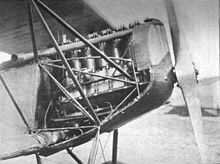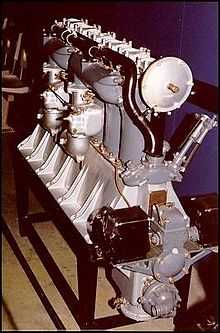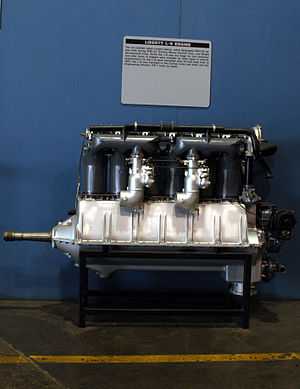Liberty L-6
The Liberty L-6 was a six-cylinder, water-cooled, inline, aero-engine developed in the United States during World War I.
Design and development

Fokker D.VII with Liberty L-6 engine fitted for trials
The Liberty L-6, which developed 200-215 hp, was built by the Thomas-Morse Aircraft Corp. and Wright Aeronautical Corp. Since it was based on the same engine design as the more successful Liberty L-12 V-12 liquid cooled aviation engine, the L-6's resemblance to the Mercedes D.III German aviation engine, the source for the Liberty V-12's own cylinder and valvetrain design, resulted in the American L-6 engine design bearing a close visual resemblance to the German straight-six aviation powerplant in a number of respects, with at least one L-6 even being mounted postwar into a captured Fokker D.VII fighter for testing in the USA.
Since the L-6 was too large for mail airplanes and other engines were available, the L-6 was canceled after only 52 had been built. In 1920 10 more L-6 engines were ordered, designated L-825, several of which were installed in the Curtiss PN-1, (only two built), and the Engineering Division TW-1, (only six built).
Specifications

Rear view of restored Liberty Six engine
Data from U.S. Army Air Service Information Circular - Performance Test of Fokker D-VII with Liberty Six Engine
General characteristics
- Type: Six-cylinder inline piston engine
- Bore: 5.00 in (127 mm)
- Stroke: 7.00 in (177.8 mm)
- Displacement: 824.67 in3 (13.51 litres)
- Dry weight: 567.5 lb (257.4 kg)
Components
Performance
- Power output: 215 hp (162.6 kW) @ 1,700 rpm
- Compression ratio: 5.42:1
- Fuel consumption: 0.49 lb/HP-hour
- Oil consumption: 0.0256 lb/HP-hour
See also
- Comparable engines
- Related lists
References
This article incorporates text from http://www.nationalmuseum.af.mil/factsheets/factsheet.asp?id=837, a public domain work of the United States Government.
|
|---|
| | General | |
|---|
| | Military | |
|---|
| | Accidents / incidents | |
|---|
| | Records | |
|---|
| | Misc. | |
|---|
|


